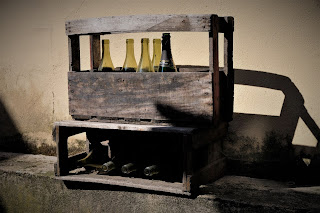 |
| Taos Pueblo |
Taos Valley RV park is on the pricey end of the scale and we only scored an ‘overflow’ spot as we had no reservation. The two other RV parks looked like places to avoid at all cost.
I did some overdue washing using the big US washing machines – all
speed and no effectiveness - I pulled out items that managed to have patches of
dry remaining on them. The clothes dryers are something else though – items too
hot to hold and all done in 45 mins.
Taos Pueblo was
a few miles north of Taos itself and is the oldest continuously occupied settlement
in the US. The day was brilliant sunshine as usual and the ochre adobe
structures with their turquoise woodwork, some resembling apartment blocks,
stood out in stark relief against the sapphire sky. Little pizza oven things
were dotted around and to satisfy my curiosity I ordered a blue corn fry-bread.
It was sprinkled with cinnamon and icing sugar and looked a bit like an oily
chapati – curiosity satisfied, I didn’t order any more.
 |
| St Francis of Assisi church, a landmark in Taos |
 |
| Bandalier National Monument Climbing up to see where the Pubeloan people lived, I didn't like this bit |
Things in the
cab don’t always go smoothly and my intentions didn’t co-incide with the
driver’s understanding, therefore we ended up in Bandalier National monument. A
serendipitous outcome as it had a lovely campground set among the junipers.
Each campsite had all the usual equipment plus a large bear-bin, I don’t know about
the bear but I certainly couldn’t open it.
We trekked downhill 1.5 miles to the
visitor centre getting a fabulous view of the ancient ruins on the way. A
shuttle service delivered us back to our camp at the end of the day.
 |
| Groves (left) and Oppenheimer, the main drivers behind the creation of Los Alamos |
Bandalier
National monument (a national park) is on the doorstep of Los Alamos town. More
swearing in the cab before we finally parked the oversize gaudy beast. We had
to go through ‘checkpoint Charlie’ who made us turn around and detour around
the LABORATORY.
Los Alamos was
created specifically to engineer an atom bomb to end WWII. The location was out
of range of enemy bombers and set on a high defensible plateau. A collaboration
of US, UK and Canadian scientists with quite a few Jewish scientists fleeing
Europe joined the Manhattan Project. Within two years the bombs that were
dropped on Hiroshima (‘Little Boy’) and Nagasaki (‘Fat Man’) had been created
and deployed.
Los Alamos was a ‘town that never was’, at the time officials denied its
existence and access was a dirt road from Santa Fe. Eventually there was a
rough road made of chip and seal to replace the dirt road. The ranger told us
the chip and seal is not like roads the US has today - sorry to say that is still
what NZ roads are made of.
 |
| Stuart looking at full size replica of "Little Boy" named after Eisenhower with 'Fat Man' replica (Churchill) in the background) |
We visited
history and science museums and the house where the head scientist lived, it
had a bath unlike most of the other accommodations which were allocated
according to employee importance.
Today the town looks decidedly bland but was
decked out in brilliant autumn yellows glowing against a blue sky. We had to
show passports to take the road out of town and on our way glanced across at the
installation that gets $US2 billion a year to research and develop nuclear
weapons. Food for thought indeed.
We are swinging back in the direction of Las Vegas taking in a few State parks with bits of Route 66 thrown in. We struck a bad patch of campgrounds either being full or unsuitable and with the day growing darker Wikicamps suggested the Walmart carpark which welcomes RVers parking overnight.
So - I didn't get to be "standin' on the corner in Winslow Arizona, such a fine sight to see..." but I did get to stay overnight in the Winslow Walmart and we made use of their excellent restrooms the next morning. We were not the only ones though, there were 8 other campervans plus a couple of trucks thrown in.
Adios mes amigos, after we return the truck we have a weeks siesta in Noosa, somewhat more familiar ground, before returning home.
We are swinging back in the direction of Las Vegas taking in a few State parks with bits of Route 66 thrown in. We struck a bad patch of campgrounds either being full or unsuitable and with the day growing darker Wikicamps suggested the Walmart carpark which welcomes RVers parking overnight.
So - I didn't get to be "standin' on the corner in Winslow Arizona, such a fine sight to see..." but I did get to stay overnight in the Winslow Walmart and we made use of their excellent restrooms the next morning. We were not the only ones though, there were 8 other campervans plus a couple of trucks thrown in.
Adios mes amigos, after we return the truck we have a weeks siesta in Noosa, somewhat more familiar ground, before returning home.



















































